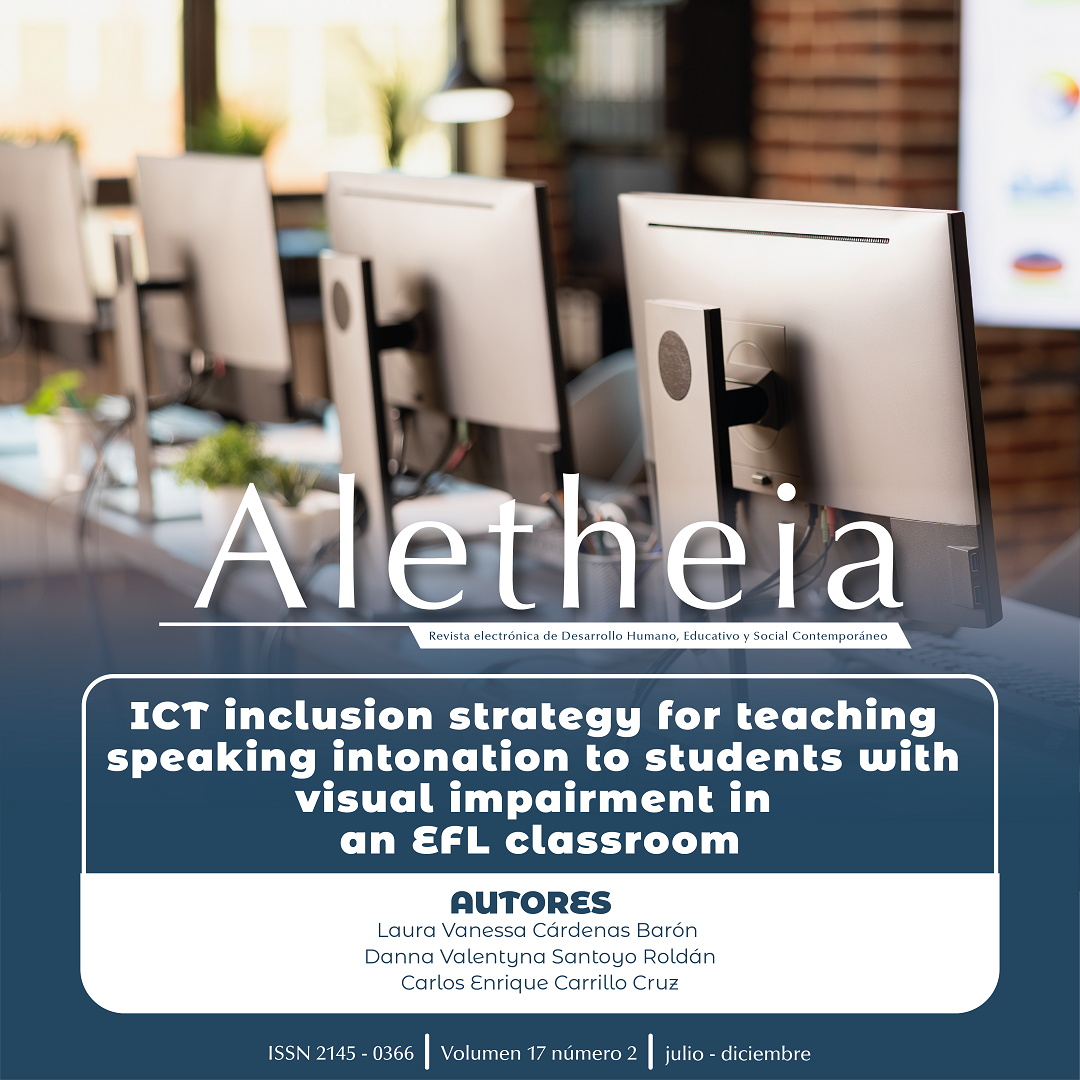ICT inclusion strategy For EFL Training Speaking Intonation in an Inclusive Classroom
Main Article Content
Abstract
This article addresses a qualitative research on Speaking Intonation for EFL context within inclusive encounters. This research aims to inspire educators to adopt innovative strategies that ensure equitable access to language learning content. Data gathering conveyed documental analysis, structured interviews, and reflective journals from pre-service teachers. Initial findings might reveal the effective enclosure of ICT tools towards oral linguistic output modeling. In conclusion, pronunciation accuracy may be boosted by means of the rapid development of Information and Communication Technologies incorporation.
Downloads
Article Details
Issue
Section

This work is licensed under a Creative Commons Attribution-NonCommercial 4.0 International License.
Authors publishing in this journal agree to the following terms: a. The authors retainthe copyright to the journal and ensure the right to be the first publication of work asLicensed under a Creative Commons Attribution License that allows others toshare the work with an acknowledgment of the authorship of the work and the initial publication in this magazine. b. Authors may establish separate additional agreements to the non-exclusive distribution of the version of the work published inthe journal (for example, place it in an institutional repository or publish it in a book),with an acknowledgment of its initial publication in this journal. c. It allows and encourages authors to disseminate their work electronically (eg, in institutional repositories or on their own website) before and during the submission process,as it can lead to productive exchanges, as well as a subpoena more early andmost of the published (See The Effect of Open Access) (in English).
References
Agudelo Gómez, P. A., & Ospina Alvarado, M. C. (2021). Inclusión, una mirada hacia la comprensión de las voces de los docentes. Revista Aletheia, 13(1), 135–156. http://aletheia.cinde.org.co/index.php/ALETHEIA/article/view/611
Bowen, G. A. (2009). Document analysis as a qualitative research method. Qualitative Research Journal, 9(2), 27–40. https://doi.org/10.3316/QRJ0902027
Bocconi, S., Dini, S., Ferlino, L., Martinoli, C., & Ott, M. (2025). ICT Educational Tools and Visually Impaired Students: Different Answers to Different Accessibility Needs. Institute for Educational Technology. 10.1007/978-3-540-73283-9_55
Carrillo, C.E. (2020). El filtro afectivo positivo como estrategia de estimulación neurocognitiva para la modificación de conductas negativas en un niño en condición de discapacidad. https://doi.org/10.18041/978-958-5578-44-9
Carrillo Cruz, C.E., Simanca, F., Cuesta, J., Angarita, N., Ruiz, D. (2021). Creation of an app towards language learning enhancement. In Universidad Libre, Innovation in ELT (pp. 79-95). Universidad Libre. https://doi.org/https://doi.org/10.18041/978-958-5578-80-7
Campbell, S. (2014). What is qualitative research? Clinical Laboratory Science: Journal of the American Society for Medical Technology, 27(1), 3-5. https://doi.org/10.29074/ascls.27.1.3
Ciria-López, A. (2017). Pronunciation and intonation patterns in EFL: A didactic proposal (Master's thesis, Universidad de Jaén). https://hdl.handle.net/10953.1/6489
Creswell, J. W. (2013). Qualitative inquiry & research design: Choosing among five approaches (3rd ed.). SAGE Publications. https://tinyurl.com/3jsswsb4
Dahniar, D., Rusadi, L. O., Halim, N. M., y Taufik, M. (2022). The design and implementation of reading aid tools based on Raspberry Pi for blind EFL students. Klasikal: Journal of Education, Language Teaching and Science, 4(3), 795–803. https://doi.org/10.52208/klasikal.v4i3.616
Fansury, A. H., Lutfin, N., & Arsyad, S. N. (2019). Audio books as teaching media to blind students in learning EFL. https://doi.org/10.52208/klasikal.v1i1.4
Hasan, M., Islam, A. B. M. S., & Shuchi, I. J. (2021). Using mobile-based formative assessment in ESL/EFL speaking. JOLLT Journal of Languages and Language Teaching, 9(1), 117–125. https://www.researchgate.net/publication/348751037_USING_MOBILE-BASED_FORMATIVE_ASSESSMENT_IN_ESLEFL_SPEAKING
Larassati, A., Setyaningsih, N., Suryaningtyas, V. W., & Cahyono, S. P. (2022). Using Praat for EFL English pronunciation class: Defining the errors of question tags intonation. Language Circle: Journal of Language and Literature, 16(2), 123–136. https://doi.org/10.15294/lc.v16i2.34393
Lintangsari, A. P., & Emaliana, I. (2020). Inclusive education services for the blind: Values, roles, and challenges of university EFL teachers. International Journal of Evaluation and Research in Education, 9(2), 439–447. https://files.eric.ed.gov/fulltext/EJ1256130.pdf
Lutovac, S., & Flores, M. A. (2022). Conceptions of assessment in pre-service teachers’ narratives of students’ failure. Cambridge Journal of Education, 52(1), 55–71. https://doi.org/10.1080/0305764X.2021.1935736
Mestre Segarra, M. A. (2017). How to teach intonation to EFL students: A focus on communicative teaching methods. Fòrum de Recerca, 22, 467–505. https://doi.org/10.6035/ForumRecerca.2017.22.28
Ministerio de Educación Nacional. (2017). Documento de orientaciones técnicas, administrativas y pedagógicas para la atención educativa a estudiantes con discapacidad en el marco de la educación inclusiva. SIMAT Bogotá: Autor. Retrieved September 21, 2024, from https://www.mineducacion.gov.co/1780/articles-360293_foto_portada.pdf
Ministerio de Educación Nacional. (2024). Educación virtual o educación en línea. Portal MEN. Retrieved September 21, 2024, from https://www.mineducacion.gov.co/portal/Educacion-superior/Informacion-Destacada/196492:Educacion-virtual-o-educacion-en-linea
Ou, J. C. (2022). The effect of software instruction on EFL students’ pronunciation skills. International Journal for Innovation Education and Research, 10(9), 275–282. https://doi.org/10.31686/ijier.vol10.iss9.3907
Ortlipp, M. (2008). Keeping and using reflective journals in the qualitative research process. The Qualitative Report, 13(4), 695–705. https://nsuworks.nova.edu/tqr/vol13/iss4/8/
